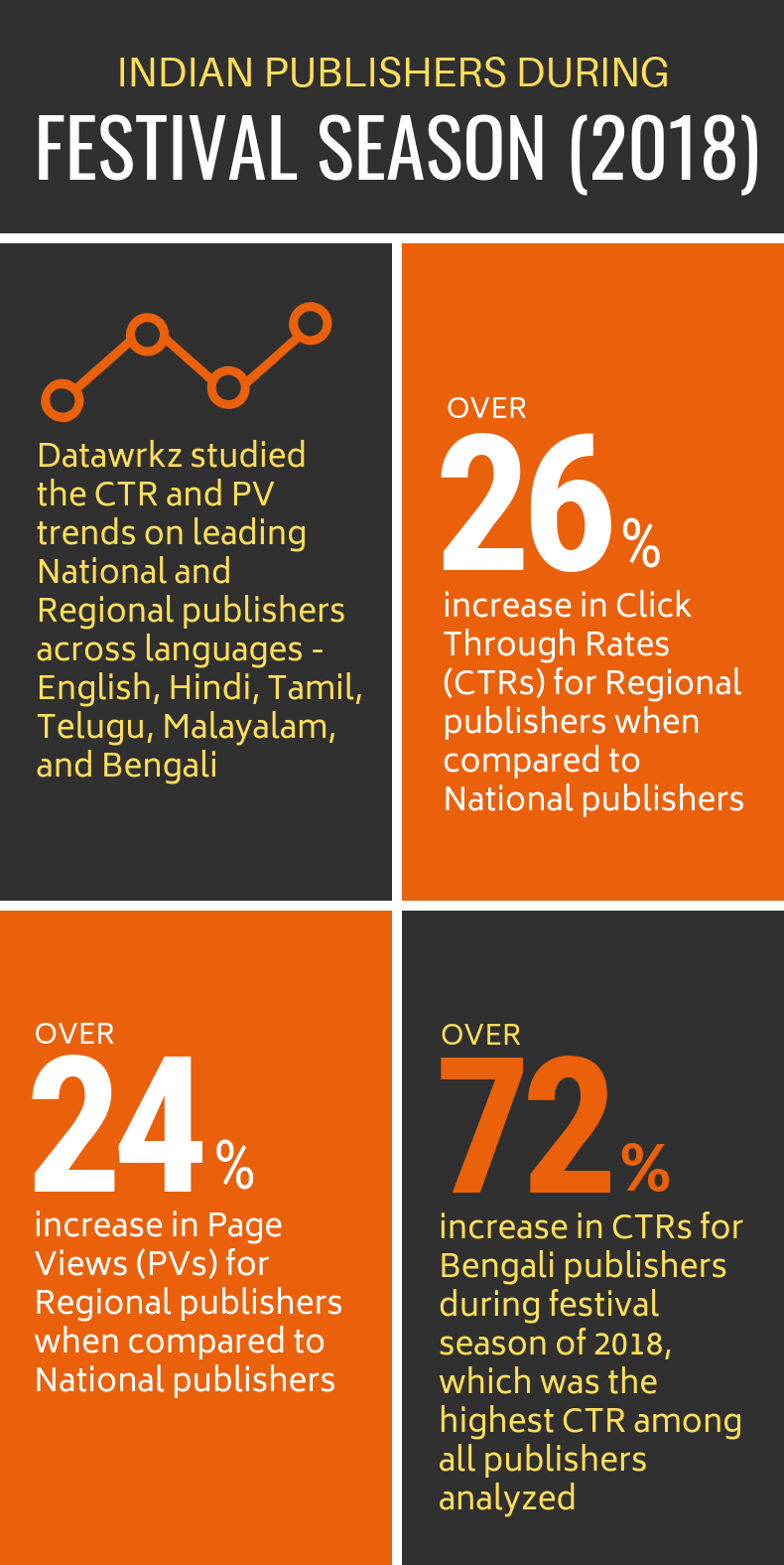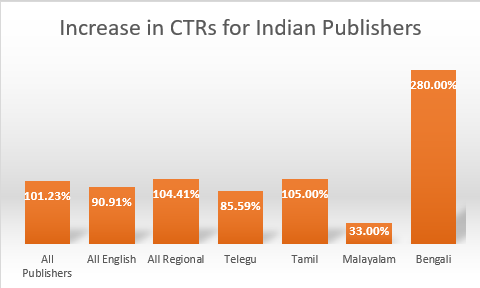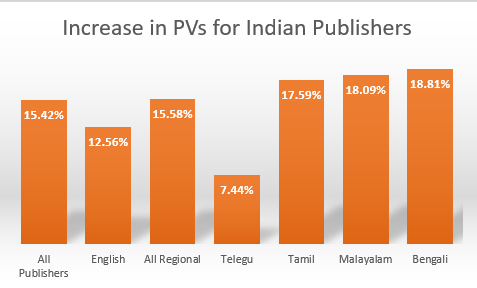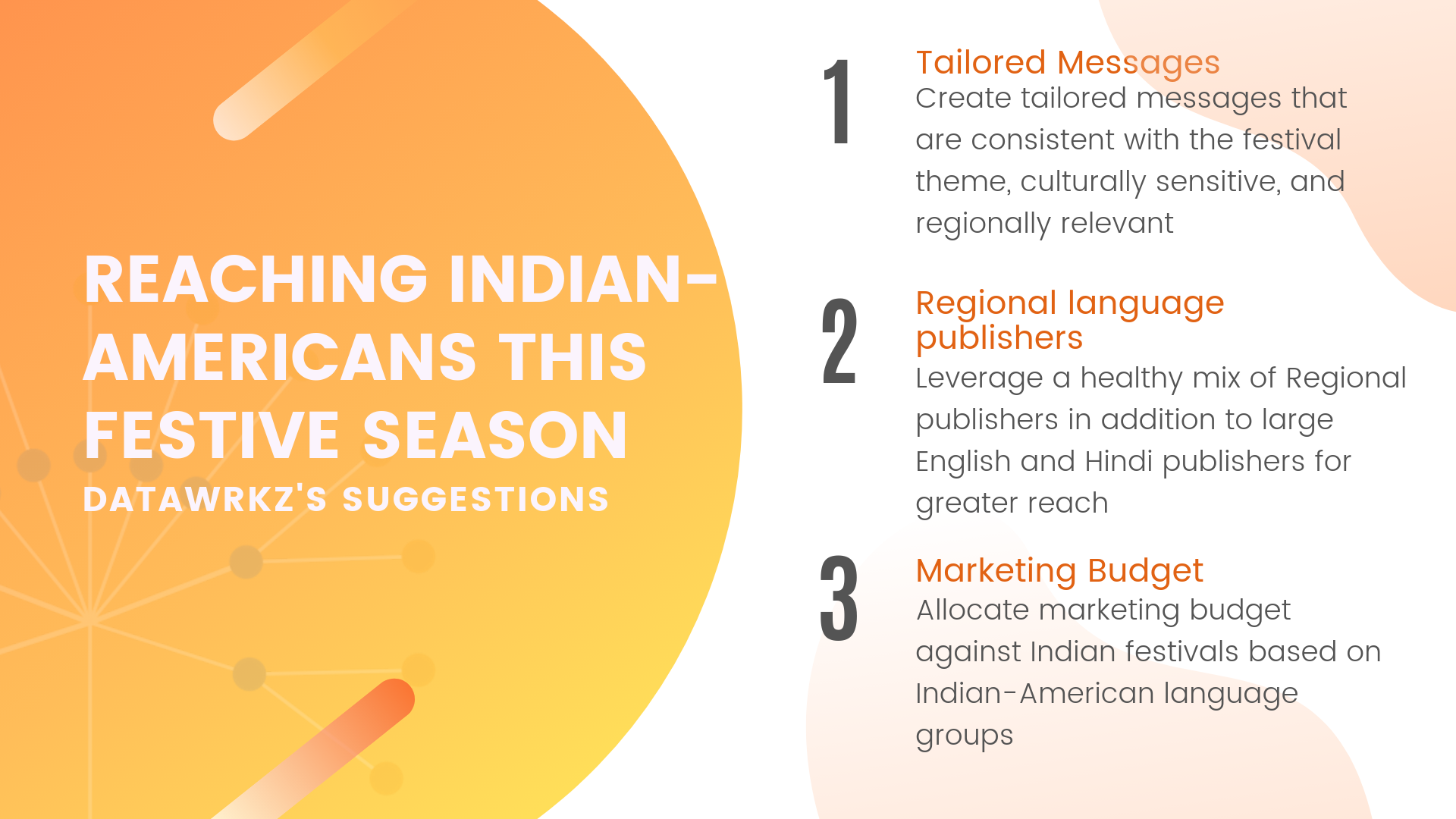Introduction
The Indian diaspora is one of the largest in the world. According to a report published by the Indian External Affairs Ministry, as of December 2018, there were close to 31 Million Indians (Non-Resident Indians and Persons of Indian Origin) around the world – larger than the population of Australia, Taiwan, Cuba, Sweden, or Switzerland. Digital Advertising makes it easy for advertisers across the globe to reach this particular demography.
With this blog, Datawrkz shares its knowledge on Indian festivals and their regional/cultural significance to Indian-Americans. It also incorporates an interesting study about the online behavior of Indian-Americans on Indian regional websites. This study forms the basis of Datawrkz’s recommendations on leveraging Indian Regional publishers to target Indian-Americans this upcoming festive season. Given there are now approximately 4 Million Indian-Americans in the U.S., there are a large number of people who would be emotionally attached to these festivals. As marketers, it is up to us to tap into this deep-rooted emotion and build a connection with the brand(s) we represent.
Celebration of Festivals by Indians is Not Homogenous
Indian festivals across religions are spread around the calendar year. Come September, the peak period of festivities begin. In fact, the Indian Independence Day, August 15th, marks the beginning of holidays and celebrations for Indians. This is followed by the major pan-Indian festivals of Dussehra/Durga Puja (October 8th, 2019), and Diwali (October 27th, 2019). Along the way, there are multiple regional festivals in various parts of India such as Raksha Bandhan (August 15th, 2019 – mainly among Hindi speakers), Ganesh Chaturti (September 2nd, 2019 – Marathi, Kannada, and Gujarati speakers), Navratri (September 29th to October 8th, 2019 – Gujarati and Hindi speakers), and Onam (September 11th, 2019 – Malayalam speakers). For brands in North America, this provides multiple opportunities to market their products and offerings to Indian-Americans.
Looking back through the list of festivals, Diwali is the only one that is celebrated with equal importance by all parts of India. Dussehra lasts for nine days and is celebrated with various levels of fervor by different Indian sub-groups. Durga Puja is a festival celebrated for nine days at the same time as Dussehra mainly by the Bengali speaking population of India and Bangladesh. For this community, Durga Puja is the main festival in the year and should be key to the messaging used when advertising to Bengali Indian-Americans.
Different Indian regions perform different activities during the nine days of Dussehra. The Dussehra period is known as Navratri (meaning nine nights) among the Gujarati communities. Gujaratis decorate special stages centered with the idol of Ambe (Indian Goddess) to celebrate Navratri and organize folk dance performances around the idol called Dandiya during these nine-days.
Ganesh Chaturti celebrates the Hindu god Ganesha and his arrival to the earth. This festival is primarily celebrated in the western and southern parts of India. An idol of Ganesha is worshiped for ‘odd’ number of days (1.5,3,5,7,11) and ends with the immersion of the idol in a water body. Onam is celebrated by the Malayali community. This 10-day festival is marked by feasts (Sadya) and flower decorations (Pookkalam) to celebrate the harvest season.
Preparations begin weeks before the actual festivities. This involves a lot of shopping for items required during the festivals; shopping not just for self but also exploring gifting ideas for friends and relatives. For example, Dhanteras, a festival that marks the beginning of the 5-day Diwali celebrations, is considered auspicious by Hindi-speaking Hindu communities around the world for making new purchases, especially gold and silver items as well as utensils. It is believed that this ritual will bring great wealth and prosperity in the coming year. Promoting Dhanteras to Tamil, Telugu, and Malayalam speaking Indians, however, would probably not relate to their cultural sub-context.
As Indian-Americans have roots in different parts of India, it becomes important to understand their online behavior on Indian National and Regional news, entertainment, political, and sports websites. This study will help the advertisers in the U.S. reach out to Indian-Americans on Indian Regional websites to establish a meaningful relationship and generate better engagement out of their online advertising spend.
Indian Regional Publishers – Preferred by Indian-Americans for Politics and Culture
In India, online publishers covering both national and regional news have been successful in their respective niches. The deep regional knowledge along with an understanding of the preferences of their audience is what makes regional publishers relevant. Indians staying in the U.S. prefer these online websites covering regional news as their news sources, leading to US-based impressions making up 15-20% of the global traffic for regional publishers.
While some regional publishers prefer to publish in English, others write in their regional languages (e.g. Telugu, Tamil, Telugu, Malayalam, and Bengali). It is interesting to note that the share of website traffic from Indian-Americans on Regional websites publishing content in English (15-20%) is almost similar (15-18%) to that of publishers with regional language content.
For the purpose of this study, Datawrkz has considered:
- Publishers covering national news in English and Hindi as National publishers.
- Publishers covering regional news in both English and regional language as regional publishers
Below is a table to help you understand the regions these regional publishers cover.
| Region(s) Covered | Publisher Nomenclature (used in the blog) |
| India | National |
| Tamil Nadu | Tamil |
| Andhra Pradesh and Telangana | Telugu |
| Kerala | Malayalam |
| West Bengal and Bangladesh | Bengali |
Indian-Americans on Indian National and Regional Websites – A Comparative Study
Datawrkz studied the online behavior of Indian-Americans on Indian National and Regional publishers across the country, specifically their Page View (PV) and Click Through Rate (CTR) trends. A comparative study was done over two time periods of 26 days each:
- Sep 19 to Oct 14, 2018: Before the festival period
- Oct 15 to Nov 10, 2018: During the peak festival period (Dussehra to Diwali)

Indian-Americans on Indian websites – CTR Trends

The increased PV numbers for Indian publishers during the festive season not only resulted in a jump in the ad impression numbers but also the CTRs, meaning the audience was engaging better with advertisements during the festive season. Here are some interesting findings:
- Datawrkz observed an average increase of over 53% in CTRs across National and Regional publishers during the festival season when compared to the non-festival period.
- The average CTR increase of 61% for Regional publishers was 26% higher than the average increase of over 48% for National publishers during the festive season of 2018.
- Region-wise, Datawrkz saw an average increase of 44%, 64%, 33%, and 72% in CTRs on Tamil, Telugu, Malayalam, and Bengali publishers respectively.
Indian-Americans on Indian websites – PV Trends

- The overall average PVs were higher by 15% for National and Regional publishers during the festival season when compared to the non-festival period. This increase in PVs is indicative of the awareness, knowledge, and experience of Indian publishers in producing quality content that is relevant to the festive season and the success it has in garnering the attention of Indian readers across the world.
- An average increase of 13% in PVs for all observed English & Hindi language publishers was overshadowed by the 16% increase in PVs for Regional publishers. The increase in PVs for Regional publishers during the festival period was over 24% higher than National publishers in the same period. This shows the engagement Regional publishers have on content related to general news, entertainment, and political news, which is consumed by Indian-Americans.
- Region-wise, the average PV increase for Tamil, Telugu, Malayalam, and Bengali publishers were 18%, 7%, 18%, and 19% respectively.

Festival season is more than just about celebrations; it is about family and emotional resonance. Marketers should make use of this opportunity, tap into the emotional side of the audience and create messaging that is consistent with the festive theme to garner the attention of their target audience. Most importantly, Datawrkz suggests creating tailored messages that are culturally relevant to sub-groups within the Indian-American community rather than a one-size-fits-all messaging strategy across all Indian-Americans.
Datawrkz also recommends leveraging a healthy mix of Regional language publishers in addition to large English and Hindi publishers. Advertisers can get higher reach for a lower CPM on Regional publishers (as compared to CPM rates on top National publishers during festival season), as well as see greater engagement too. Increasing the marketing budget during this season will do wonders as well. People are ready to spend more willingly during the festival season and aggressive online advertising will generate greater revenues for advertisers.
The festival season starts in a few days. Get ready and get cracking!
Datawrkz has been helping publishers across South Asia and South-East Asia monetize their website(s) with its proprietary Supply-Side technology for 6 years now. In India, Datawrkz works with leading English, Hindi, and Regional language publishers. With its Supply-Side expertise, Datawrkz has built relationships and rapport with publishers that is unparalleled in the South Asian and South-East Asian markets. Datawrkz can help advertisers/agencies in the U.S. reach Asian-Americans through its network of publisher partners across South Asia and South-East Asia with guaranteed impressions, 75%+ viewability, access to the first-look audience, and up to 0.3% CTRs. Reach out to multicultural@datawrkz.com to know more.










